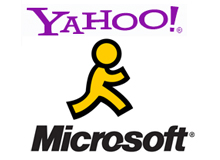Startaround (noun): An established company that must think and operate like a startup as it undergoes a turnaround.
Though the term “startaround” is not in any digital-age lexicon, it might soon be. That’s the word Brad Garlinghouse, president of AOL consumer applications, used to describe his company during the recent Supernova conference in Philadelphia. The ailing Internet services firm celebrates its 25th anniversary this year, and Garlinghouse, along with the rest of AOL’s management, has been charged with turning the company around by focusing on its next “big bet” — that is, “reinventing how content is created and monetized.”
Of all the Internet stars of the 1990s dot-com boom, AOL’s rise and fall was perhaps the most dramatic. And so far, the company’s attempts to stop its backward slide have been far from smooth. Like many other established Internet firms, AOL knows that its business model needs to undergo a radical transformation or it will be supplanted by a new generation of sharper online startups. After riding high in the 1990s as a fast-growing company, AOL’s business began rapidly unraveling following the bursting of the dot-com bubble and the company’s ill-fated $350 billion merger with media conglomerate Time Warner in 2000. Despite working relentlessly to grow advertising revenue to offset its declining dial-up Internet access unit, AOL is still a shadow of its former self.
The company’s attempt at transformation — or what Garlinghouse referred to as its “second act” — jettisons old expansion plans to focus on premium revenue generation. The process has required massive budget cuts, staff reductions and controversial divestments — in some ways, a return to the company’s lean startup days. Nonetheless, Garlinghouse said he is a big believer in second acts on the Internet — and perhaps even third and fourth acts. “There’s no question there will be second acts in the Internet space,” he noted. “Amazon has [had] second and third acts with the Kindle and Amazon Web Services.” What’s important, he added, is that, just like a startup, “innovation needs to be everywhere” for a company like AOL to cope with the digital age’s constant state of flux.
Finding new ways to regain the appeal that older or fading Internet companies once had with consumers is by no means easy, Wharton experts say. Companies like AOL, Yahoo and even Microsoft “have lost their ‘mojo,'” suggests Kevin Werbach, a Wharton legal studies and business ethics professor. “They are kind of stuck.”
Spoon-Feeding the Masses
According to David Hsu, a management professor at Wharton, the strategies of firms like AOL, Yahoo and Microsoft worked well in the late 1990s and early 2000s. They set up portals designed to spoon-feed content to the masses and positioned those sites as a guide to what was then a new and often daunting communications environment. “The appeal of the portal approach was that people were uneducated about navigating the web. Yahoo, AOL and Microsoft with MSN stepped in and said, ‘We’ll make it simple for you,'” Hsu points out.
It’s unclear how well that approach works today. The arrival of Facebook and other social networking sites has helped spawn a new generation of Internet-savvy users who are far more proactive about tailoring the content they access online than they once were. “There’s something that many consumers appreciate about the disconnected web. Consumers would rather be interconnected with their circle of friends” than use a more anonymous portal, such as AOL or Yahoo, notes Wharton legal studies and business ethics professor Andrea Matwyshyn, adding that this focus on social connections means Facebook is often the new starting page for web users.
But while AOL, Yahoo and Microsoft may be viewed as has-beens that can’t compete with the new generation of Internet startups, they have something many others don’t — a massive audience. According to the latest monthly research results from ComScore, Google had 179 million unique users in the U.S. alone in June, but Yahoo wasn’t too far behind, with 167 million. Microsoft was in third place with 160 million unique users, while AOL had 112 million. “The continued viability of these dinosaurs shows that there’s something to be said for aggregating an audience,” says Peter Fader, a Wharton marketing professor and co-director of the Wharton Interactive Media Initiative.
Yet as companies like these now try to change their business models to include a wider or different array of online services, one danger they face is that they might lose their big audiences. “Maybe these portals don’t have to do too much [to change],” Fader suggests. “They could just recruit more passive viewers like the TV industry. The risk is that they try and do too much and destroy whatever success they’re having.” Hsu agrees. “The risk is that you spread resources too thinly and you lose sight of what you do well. What are the costs of reinvention for AOL, Yahoo and Microsoft?”
The costs are undoubtedly high. According to Matwyshyn, that could be one of the reasons large companies like AOL, Microsoft and Yahoo struggle to be innovative. “It may be that the more established they become, the less willing they are to risk existing market share and capital on unproven projects.”
One Step Forward?
But when it comes to being an Internet “startaround,” companies like AOL often have little choice but to take those risks. In a break with its past, CEO Tim Armstrong and his new team have begun pursuing higher-end advertisers. The transition has been partly blamed for the company’s year-on-year 27% drop in second quarter 2010 advertising revenue, to $297 million. Overall revenue fell 26%, to $584 million from $791.5 million in 2009.
Another reason for the decline is the company is retrenching, as it returns to leaner operating budgets and staff numbers. Starting in January, AOL has been closing offices across Europe, shedding nearly 2,500 jobs along the way. During AOL’s second quarter earnings conference call on August 4, Armstrong said that, despite losses of $1 billion, the company is “getting healthier…. It’s really about taking a company that was very sick and making it healthy.”
Today, as Garlinghouse told the Supernova conference audience, “the best thing AOL has going for it” — as with a promising startup — “is that it hired a lot of people with a track record of winning” after a spinoff in 2009 let the company break free from Time Warner. Armstrong was hired from Google, while other executives are from Apple, Yahoo and Digg. Garlinghouse was previously with Yahoo, where he oversaw, among other business lines, Yahoo Mail and its Flickr photo-sharing service.
Along with fresh management teams, deal-making has also been critical. “The Internet generates a shorter product cycle [than other sectors],” Matwyshyn notes. “These companies have to continually reinvent themselves and come up with new products, but much of that innovation is through acquisitions, not internal development.” Internet companies can be drawn to what are often disastrous deals because of the sector’s pressure to roll out new products quickly, something that’s not always easy to do organically, she adds.
AOL knows first-hand how tricky M&A can be in such a fast-changing sector. Two years after buying social networking company Bebo in 2008 for $850 million, AOL recently said it “was not prepared to invest the capital necessary to turn the service around in light of its declining user base and ad revenue.” Earlier this year, AOL sold Bebofor an undisclosed sum to Criterion Capital Partners, a private equity fund in Los Angeles. Technology blog TechCrunch estimated the sale price to be no more than $10 million.
Despite the risks, M&A and partnerships now feature heavily in Yahoo’s reinvention, which wasn’t always the case. Of the Internet mavericks, Werbach points out, “Yahoo was one of the most successful,” and beat back rivals like Excite and AltaVista in the portal and search wars of the late 1990s. But its spurning of Microsoft’s 2008 takeover offer led to a strategy and management shakeup at the top, including the appointment of Carol Bartz — like Armstrong, another Silicon Valley veteran — to replace CEO Jerry Yang, one of the company’s co-founders.
Since taking the helm in 2009, Bartz has set up a partnership with Microsoft’s Bing search and advertising platform and plans to expand Yahoo News and other key sites like Yahoo Mail, Sports and Finance to help increase the time visitors spend on a property. She has also divested companies recently acquired by Yahoo, such as Zimbra, a corporate e-mail service, and HotJobs, a job-search site, which no longer fit with the company’s portfolio of businesses. Meanwhile, Yahoo bought Associated Content, an online network with 380,000 freelance contributors generating content for its site. According to Bartz, Yahoo’s strength is “preparing editorial expertise with a huge treasure trove of data on Yahoo about users, their interests and their intent, [and] delivering content that we know they want and will respond to.”
Yahoo is also joining forces with Facebook, rather than trying to build a competing product. “Users who are on both Yahoo and Facebook can link their accounts to view and share updates with friends across both networks,” Bartz told an analyst conference in July. “We call this new level of social integration ‘Yahoo Pulse.’ It’s still in early innings, but so far we’re encouraged by what we’re seeing. “
The search engine’s financial results have also waned over the years, but not as dramatically as AOL’s. Though Yahoo didn’t see Google coming in the search arena and failed to fully capitalize on search advertising, it has fared reasonably well. Revenue growth tailed off in 2009 to $6.5 billion from $7.2 billion the previous year. However, net income for 2009 was $598 billion, up from $419 billion.
The way Hsu sees it, partnerships and acquisitions are indeed the way to grow, especially since “it’s unlikely any company will dominate the consumer web.” In particular, Hsu says he is a fan of Yahoo’s deal with Facebook, because a partnership makes more sense than trying to beat the social networking leader. Microsoft’s search partnership with Yahoo may also be a good move, he adds.
Experts at Wharton also point out that AOL, Yahoo and Microsoft have an advantage over rivals — deeper pockets to compete with the likes of Google, Facebook and Twitter, which gives them more room to maneuver than they had in their early years. “Think about Yahoo. The margin for error is greater now because it has a stronger foundation than when it was a startup,” says Werbach.
Then there’s Microsoft. In the 1990s, Microsoft formed its MSN Internet access service to compete with AOL, and offered e-mail, photo and storage services online while also forging ahead with its formidable Windows and Office software products. But like Yahoo, Microsoft didn’t see Google coming. Now, it wants to build an ad network that can compete with Google.
Much of Microsoft’s current Internet focus revolves around Bing. Unveiled last year in a $100 million campaign, the new advertising and search platform replaces its Live Search with new features designed to cut through the clutter on the Internet. During the company’s financial analyst meeting in late July, CEO Steve Ballmer said it’s “quite stunning to think we just launched Bing 13 months ago…. I was flattered to see that our visual differentiation has been a source of concern to Google, to see them emulating us in some ways.”
But such ventures haven’t helped bottom-line growth much at the Seattle-based company, whose group operating income increased 15%, to $24 billion, in the last fiscal year, thanks largely to software sales. The last time Microsoft’s online services unit turned a profit — $5 million — was in 2006. For the year ending June 30, 2010, Microsoft’s online unit had an operating loss of $2.3 billion on revenue of $2.2 billion, compared with an operating loss of $1.65 billion on revenue of $2.1 billion the previous year.
Wharton experts agree that markets will largely measure Microsoft’s Internet success on how well it provides search for Yahoo and takes market share from Google. And as with AOL and Yahoo, “there are challenges [related to] staying current and in touch with the user base,” notes Matwyshyn.
Other Wharton experts suggest that all three of the Internet companies are still a work in progress. With the success of “second acts” uncertain, “these companies have to be careful not to fight the last war,” says Werbach. “They shouldn’t try and beat Google and Facebook.” Indeed, they should play to their strengths. “Portals aren’t dead. These sites have a lot of eyeballs and work as well as they [ever] have, but it’s unclear whether you need a ‘home’ on the Internet anymore. They could use some clarity, like General Electric, which wants to be number one or number two in every market.”



